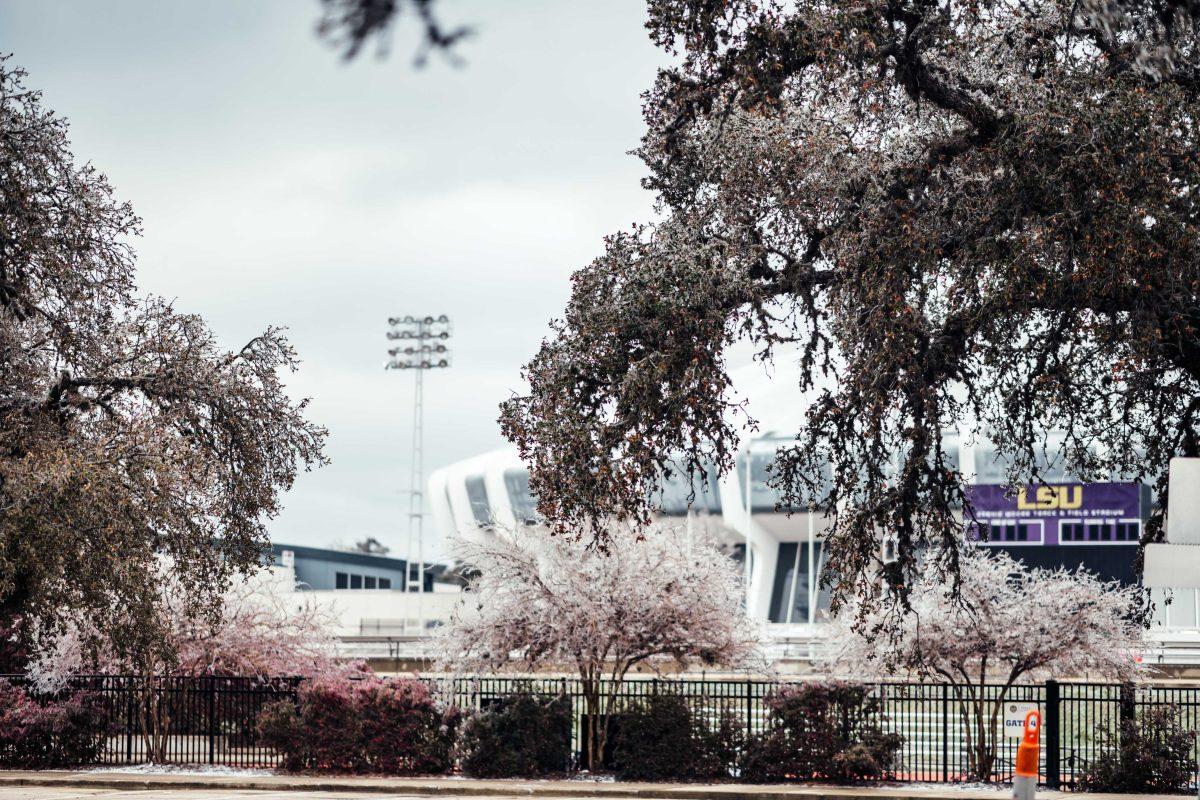As some LSU students enjoyed two “snow days,” others faced power outages amid freezing temperatures caused by a winter storm.
Baton Rouge spent 64 consecutive hours below freezing temperatures this past weekend, setting records as the fifth longest freeze in its history.
The winter storm brought conditions that caused hazardous driving conditions, power outages and below-freezing temperatures across LSU’s campus beginning on Feb. 15 and lasting throughout the early portions of the week. The University remained closed on both Feb. 15 and Feb. 17 due to the conditions, with Feb. 16 being the previously scheduled Mardi Gras holiday.
Media Relations Director Ernie Ballard said Nicholson Gateway Apartments experienced some power outages Monday, as did some Greek houses. The buildings impacted by the power outage are on Entergy’s grid.
After the University was made aware that Entergy may not return power until later Monday night, each sorority began making accommodations for its members living in the houses. Ballard said Greek organizations’ housing corporations may have had generators brought in Feb. 15 as well.
Alpha Phi provided hotel rooms for its members and offered extra rooms to some Pi Beta Phi members without power, two Pi Beta Phi members confirmed.
Biological sciences sophomore and Pi Beta Phi member Margaret Turner lives in the Pi Beta Phi house. Turner said the power went out in the house Monday morning, and residents did not have lights, heaters or working outlets. She stayed there for most of the day but stayed with her mom that night through Wednesday.
“All the girls left the Pi Phi house because we knew the house would get freezing cold with it being 18 degrees outside that night and morning,” Turner said. “We have no idea when it’ll be back on.”
Psychology senior Payton Silburn lives in Nicholson Gateway and said his apartment lost power Monday night.
“My apartment was really cold,” Silburn said.
According to an email sent on Tuesday to Nicholson Gateway residents, Res Life was working with Entergy and the facilities team to reach a solution about the power outages. Residents were asked to submit work orders in the housing portal if they are experiencing power or heating outages.
“This simple step helps our team identify where the problems are since all apartments are not experiencing the same levels of outage,” the email read.
Psychology junior Eryn Lowe, a Nicholson Gateway resident, said she relocated to her friend’s house due to the problems persisting at her apartment.
“I wasn’t able to get an internet connection in my bedroom, and my roommate took a shower and said we had no hot water,” Lowe said. “I had to leave my apartment to go to my friend’s house, but some students have nowhere to go.”
At around 5 p.m. Tuesday evening, Res Life sent an email to Nicholson Gateway residents about overnight housing options.
“We are not confident power will be completely and consistently restored to all of Nicholson Gateway before dusk,” the email read.
The email encouraged residents to seek alternate housing options for Tuesday evening. LSU Housing offered temporary on-campus housing options that residents could apply for before 6:30 p.m. Tuesday night through a form.
“If you opt to remain in Nicholson Gateway Apartments, please prepare as if you will not have power and heat overnight,” the email read. “Stock up on blankets and warm clothes.”
Lowe noticed that although Nicholson Gateway was out of power, Tiger Stadium was still fully illuminated.
“Tiger Stadium gets to receive power and be lit up while students are freezing,” Lowe said.
Ballard said Tiger Stadium is on “campus power” while Nicholson Gateway is on Entergy’s grid, so “it’s two separate power sources.”
Some housing communities on campus were still experiencing power outages Wednesday. Power would be restored to all campus communities by the end of the day according to an email sent out by Res Life Wednesday morning.
At least one tree is down on campus, according to Ballard. Ballard said Wednesday that there were still icy spots on sidewalks and roads.
Executive Director of Facility Services Tammy Millican said there was very little damage to campus facilities, but there is still work to be done.
“The biggest issues our staff are addressing at this time is removal of downed branches and ensuring that there are no slip hazards at building entrances,” Millican said.
When campus was closed Feb. 15, some students slid down the Indian Mounds in makeshift sleds, and one in a canoe.
The Indian Mounds are almost 6,000 years old, and could be more than 11,300 years old according to recent research by the LSU Geology Department. The University has invested over $20,000 into researching the Indian Mounds, and the historical significance of the structures has led some students to suggest that the mounds be preserved by the University.
“Whether it’s people climbing them for ‘the view’ or children playing at tailgates, no one has any business damaging these structures, and there should be consequences put in place to discourage and prevent further disregard and damage to them,” LSU geography student Sara Pellegrin told TigerTV.
LSU Native American Student Organization President Leigh-Anne Thompson authored a letter in response to the sledders.
“This blatant disregard of Native American heritage coupled with a lack of adequate signage and protection from the University is unacceptable,” Thompson wrote.
She asked the administration for “immediate funding of permanent and attractive fencing” around the Indian mounds to “ensure their protection.” She said there needs to be “appropriate signage” about the “significant historical value” of the Indian Mounds.
Thompson said NASO will host an open meeting to discuss “A History of the Misuse: The Story of the LSU Indian Mounds.” A letter template created by NASO for students interested in speaking to administrators about preservation of the Indian Mounds began circulating on Twitter.
“It is very disappointing to see people continue to walk on and slide down the Indian Mounds,” Ballard said. “We plan to continue educating people that the mounds are on the National Register, they are estimated to be nearly 6,000 years old — older than the Egyptian pyramids — and they should be respected for the historical treasure they are.”





